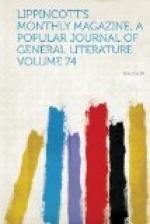can be little doubt that it became detached when the
body was moved for the purpose of placing that of
Alexander in the tomb. The white garment that
clad the skeleton of Alexander was an embroidered
shirt ornamented with lace: the legs were covered
with white leggings. The skull of this skeleton
had all the teeth perfect when the sarcophagus was
opened; but should the curiosity of any future generation
tempt the men of that day to peer into this receptacle
of the dust of tyrants, the skull of the murdered
Alexander will be found to be toothless. And all
sorts of suppositions and theories may be based on
this singular fact, and credited, until some antiquary
of the period discovers in an ancient magazine published
at the period of a former examination of the sepulchre
this record, in which I am obliged to declare—with
a blush for the decency of the Florentines—that
the teeth were all stolen by persons who were permitted
to be present at the opening of the tomb. A certain
special historical interest is attached to those teeth
of the murdered man. The story goes that when
Lorenzino stabbed him as he slept on a bed in Lorenzino’s
own house, to which he had been inveigled in the hope
of meeting there a certain lady, the wife of a Ginori
of the time, Alexander started up, and, seizing the
thumb of the murderer between his teeth, held him
so firmly that he could not have escaped had not a
bravo whom he had hired to aid him come to his assistance.
These, then, were the teeth that held so well in the
death-grip of their owner! Some Florentine historically-minded
virtuoso (!) appreciated the significance of the fact,
and stole them from the head some three centuries
and a half after that last bite of theirs. There
were several gaps in the range of teeth still remaining
in the skull of Alexander, which has appeared strange
to some who remember that he was only twenty-seven
when he died. But I think that any medical man,
taking into consideration; the manner of his death,
would find nothing strange in the circumstance, but
on the contrary a confirmation of the truth of the
facts which the chroniclers of the time have preserved
for us.
Perhaps, however, the most curious and interesting
fact which the opening of this tomb has ascertained
is that testified to by the hair still remaining on
the skull which was that of Alexander. It is a
black curly hair of a coarse quality, such as a man
of mixed black blood may be supposed to have had.
It is recorded that one of the wounds given by the
bravo Scoronconcolo, whom Lorenzino had hired to assist
him in the murder, and who ran up to complete the job
when his master was disabled by being fast held by
the teeth of Alexander, was a stab in the face.
And of the truth of this tradition also the skull
of the murdered man still affords evidence; for on
the left-hand side of the face, a little below the
socket of the eye, there is a mark in the bone beneath
the cheek which must have been made by the point of
the sword or dagger that inflicted the wound, and which
shows that the bravo Scoronconcolo’s thrust
must have been a shrewd one.




